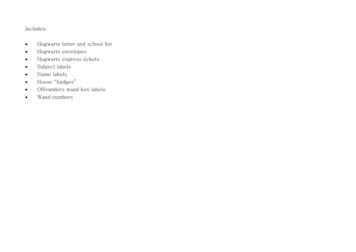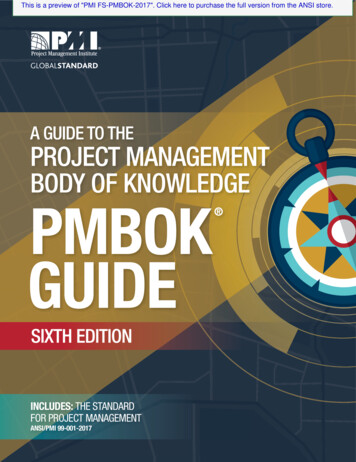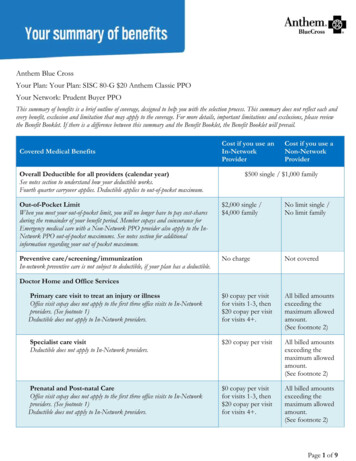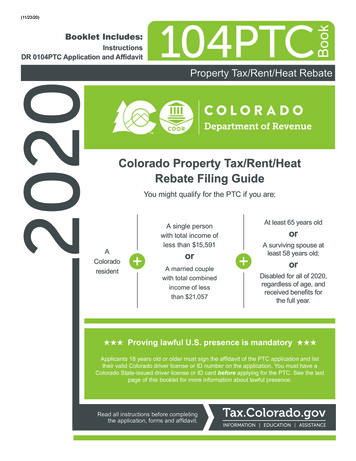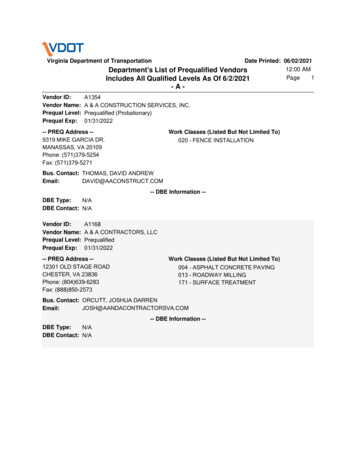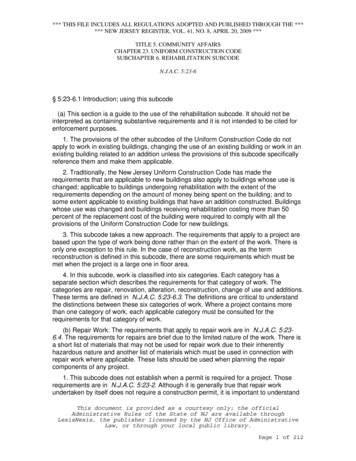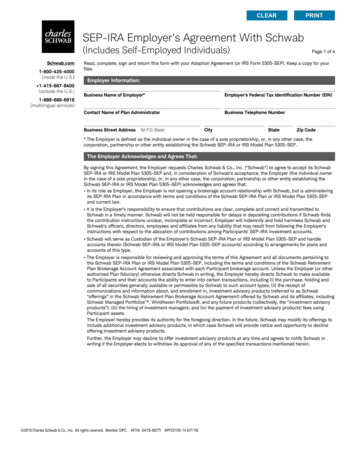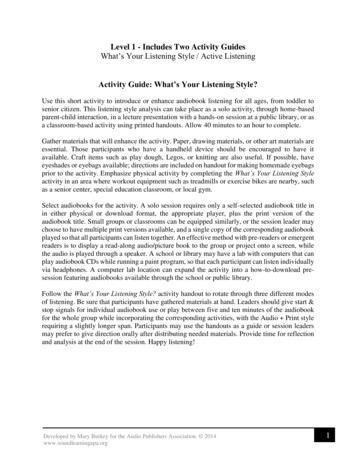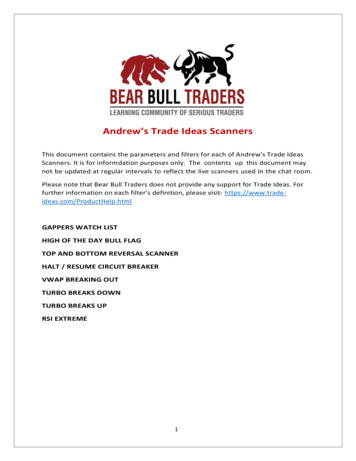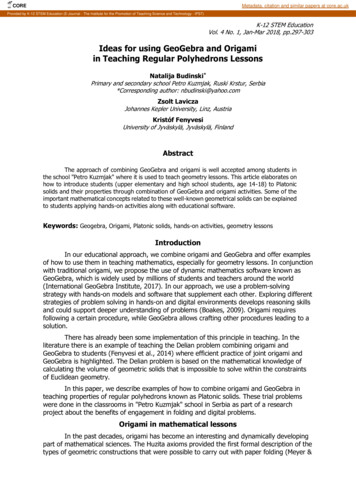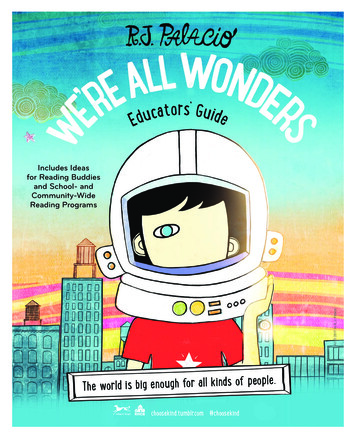
Transcription
rso’ GuidetacudEArt 2017 by R. J. PalacioIncludes Ideasfor Reading Buddiesand School- andCommunity-WideReading ProgramsThe world is big enough for all kinds of people.choosekind.tumblr.com #choosekindKN WereAllWonders ClassKit EduGd 3P.indd 12/1/17 2:54 PM
ABOUT THE BOOKThe unforgettable bestseller Wonder, soon to be a major motionpicture, has inspired a nationwide movement to Choose Kind.Now educators can introduce the importance of choosing kindto younger readers with this gorgeous picture book, featuringAuggie and Daisy on an original adventure, written and illustratedby R. J. Palacio.A boy whose face doesn’t look ordinary likes to do the samethings that other kids do. But the other kids don’t see past hisfacial difference. They don’t invite him to play, and they pointat him and call him names. When he is feeling especiallylonely, he and his dog put on space helmets and fly throughthe atmosphere. They land on Pluto, where they play withold friends. As they float back to Earth, the boy sees a world bigenough for all kinds of people. The boy’s mother callshim unique and a wonder, and he begins to think about theother kids and how they might change their view of him.Kindness is the underlying theme in this nod to a youngerAuggie Pullman, the main character in Wonder.Grades PreK-3 HC: 978-1-5247-6649-8 GLB: 978-1-5247-6650-4IN THE CLASSROOMAll children are exposed to school-yard or neighborhood bullies. They may even know what it feels like to beexcluded from a game or activity. But they may not realize how someone with physical differences feels whenothers point and call them names. It’s natural for children to be curious about those who have differences, likeAuggie in We’re All Wonders. This guide offers ideas that focus on the need to belong, individual differences,dealing with personal challenges, and kindness.It’s important that students learn how to read the pictures and connect what they see to the literary elements ofthe story. The text of this book is simple, but the message is ageless. For this reason, some of the activities aredesigned to support the learning environment of older students. Teachers are encouraged to choose the activitiesappropriate for their class. We’re All Wonders allows younger children to be included in school- and communitywide groups that are reading Wonder and sets the stage for reading more about Auggie Pullman when theyare older.PRE-READING ACTIVITIESDiscuss the cover of the book. What is different about the boy? Have the class brainstorm words that bestdescribe him. Then have students use the descriptive words and write a paragraph that portrays the boy. Make aconcluding sentence that expresses an opinion about why he is wearing a space helmet.Correlates to Common Core Standard ELA-SL.1-2.1; W. 1-2.1.Read aloud the title of the book. Have students write a paragraph that states what they think the book is about.Allow time in class for students to share their writing.Correlates to Common Core Standards ELA-W.1-2.1.KN WereAllWonders ClassKit EduGd 3P.indd 22/1/17 2:54 PM
QUESTIONS FOR GROUP DISCUSSIONWhat does the first line in the book reveal about the boy?Define ordinary. In what way is the boy an ordinary kid? How is he extraordinary?How does the author-illustrator reveal the boy’s name?Study the illustrations at the beginning of the book, and point out Auggie’s best friend. Follow Auggie and Daisythrough the entire story. Explain why Daisy isn’t in the pictures at the end of the book.Take a look at the pictures of Auggie’s classmates. Describe each student. How are they all different?What might they have in common?Discuss the meaning of unique. Why does Auggie’s mother think that he’s unique? Look at the illustration whereAuggie is standing on top of the world. Explain the crown on his head. Why does he have a star on his shirt?Discuss the meaning of wonder. Explain why Auggie’s mother calls him a wonder. What is the first hint thatother people don’t see Auggie the way his mother sees him?Study the illustration that shows how the other kids see Auggie. Which kid really doesn’t want to see him?Which kids are astonished? Which kid is about to laugh? Which kids are frowning? How are their facialexpressions rude?Which illustration reveals how sad Auggie feels when people treat him rudely?Explain how the space helmet and the water tower reveal what happens next in the story.Describe the friends he encounters on Pluto. What does this say about Auggie’s need to belong?How does Auggie show kindness to them?Follow the bird throughout the story. Explain why the bird is in flight at the end of the book when Auggie says,“We’re all wonders.”Explain what Auggie means when he says, “People just need to change the way they see.” At the end of the story,Tadeo offers Auggie a ball. How is this a gesture of friendship? Discuss how Tadeo changes the way he sees.Look at the last illustration. Why is Auggie’s eye a globe? How does this explain the way he sees?Explain how the book ends with hope.Correlates to Common Core Standards ELA-RL.1-2.1, 1-2.3, 1-2.4, 1-2.6, 1-2.7; L. 1-2.1, 1-2.4; SL. 1-2.1,-2.2, 1-2.4.CLASSROOM ACTIVITIESInvite a teacher who works with students with physical or learning differences to speak to the class. In what waysare these kids ordinary? How are they different? Ask the teacher to help students understand what they can do tomake those with differences feel that they belong. Correlates to Common Core Standards ELA-SL.1-2.1.Display photographs and books that show all kinds of people. Engage students in a discussion about the peoplethey see in the pictures. How are the people unique? Have students cut out a full-body silhouette the size of apaper doll. Then have them write on the doll five things that make them unique. Display the dolls (holding hands)on the wall or bulletin board to celebrate unity. Correlates to Common Core Standards ELA-SL.1-2.1.Read aloud Swimmy by Leo Lionni. Allow students to work with a partner and ask them to compare Swimmyto Auggie. How is Swimmy different from the other fish? Explain how he becomes part of the group. Then havethem create a dialogue between Swimmy and Auggie about being different and wanting to belong.Correlates to Common Core Standards ELA-RL.1-2.9; SL. 1-2.1.The pictures of Auggie’s classmates reveal their reaction to his facial difference. Divide the class into small groupsand ask them to create five questions that are appropriate to ask Auggie. Instruct the groups to choose words thatare kind and gentle. Allow time in class for the groups to share their questions.Correlates to Common Core Standards CCSS-ELA-SL. 1-2.1.What might Auggie’s and Daisy’s hearts desire? Have students cut out stars and write what Auggie and Daisymight wish upon a star. Create a display of stars. How many different wishes did the students create?Correlates to Common Core Standards CCSS-ELA-L.1-2.1, 1-2.2.Take a careful look at the boy that offers Auggie the ball at the end of the story. Then refer back to the pictures ofAuggie’s classmates to identify him as Tadeo. Have students share what they think Tadeo says to Auggie when hehands him the ball. Correlates to Common Core Standards CCSS-ELA-SL. 1-2.1.KN WereAllWonders ClassKit EduGd 3P.indd 32/1/17 2:54 PM
USING WE ’RE ALL WONDERS AND WONDER TOGETHERWonder is truly a portrait of and tribute to a community, which has led to its being selected for countlesscommon reading programs. The publication of We’re All Wonders will give even younger readers a chance tobe involved.For Reading Buddies ProgramsThe word buddy implies friendship and belonging, which are underlying themes in We’re All Wonders andWonder. Sharing a favorite book is the best possible introduction for newly formed buddies. Pair an olderand younger student, and encourage them to share a favorite book. Advise older buddies to select books theyread when they were younger to simplify the conversation and create a truly shared experience.Illustrations tell much of the story in picture books. Have reading buddies read the illustrations in We’re AllWonders. How is Auggie different? Which illustration reveals how lonely and sad he feels?Suggest to older readers that they do a two-minute book talk about Wonder after reading We’re All Wonderswith their younger reading buddy. Then the two should engage in a conversation about ways to help someonelike Auggie feel as though he belongs.Instruct reading buddies to locate five other picture books about belonging and kindness to use after readingWe’re All Wonders. Talk about the books and what they communicate about kindness to others. How is helpingsomeone belong about being kind?Ask reading buddies to plan ways they can demonstrate kindness to others. Then have them log their acts ofkindness for a week.School- and Community-Wide Reading ProgramsDefine inspiration. How is Auggie an inspiration to readers of all ages? How might his story inspire a schoolor community-wide conversation about the way we treat those who are different?Throughout the year, there are awareness days, weeks, and months to highlight issues related to public healthor social causes. National Bullying Prevention Month is commemorated in October. Sponsor a school- orcommunity-wide event where a panel of speakers with physical and cultural differences talk about the way theyhave been treated by others. What ways might the school and community improve issues related to bullying?Talk about ways that murals tell stories and communicate themes. Suggest that schools and communitiesprovide spaces for students and citizens to contribute to murals that depict the following themes: diversity,kindness, caring, friendship, and belonging. Then prepare a brief speech that dedicates the murals to AuggiePullman.Sponsor a school- or community-wide kindness day. Plan activities for all ages that are inclusive and encouragekindness. This might include a “Run for Kindness” race, or team activities like sack races. It might also include asing-in where songs like “We Are the World,” “The More We Get Together,” and “It’s a Small World” are sung.Art 2017 by R. J. PalacioSuggest that older students use Auggie as inspiration and create a rap titled “Changing the Way I See.”Ask them to teach the rap to younger and adult readers. Then tape a school- or community-wide rapperformance.KN WereAllWonders ClassKit EduGd 3P.indd 42/1/17 2:54 PM
BECOME A CERTIFIED KIND CLASSROOMR. J. Palacio’s Wonder has spread kindness in classrooms and communities across the country andinspired the Choose Kind anti-bullying initiative. The Certified Kind Classroom Challenge is a fun wayto instill the spirit of Wonder into your classroom by promoting, recognizing, and celebratingacts of kindness among peers throughout the school year.Here’s How Your Classroom Can Become Certified Kind:1. Label an incentive jar with an official Certified Kind label.Download labels at choosekind.tumblr.com.2. Challenge students to do kind deeds in order to fill the jar with marbles(1 kind deed 1 marble).3. Post pictures and anecdotes about your classroom’s progresson social media using the hashtag #choosekind.Please make sure that any people in your pictures are 18 or older.4. When the jar is full, take a photograph and email it tocertifiedkind@penguinrandomhouse.com along with your name, grade taught,school name, and mailing address. Post the photograph on social media usingthe hashtag #choosekind.5. You will receive an email confirmation that your classroom is Certified Kind,as well as a certificate of achievement. Your class will be listed on theCertified Kind Classroom Registry at choosekind.tumblr.com/map.#choosekindDOWNLOAD THE FREEDAILY WONDER APPAvailable for iPad and iPhoneApple, the Apple logo, iPhone, and iPad are trademarks of Apple Inc.,registered in the U.S. and other countries. App Store is a service mark ofApple Inc., registered in the U.S. and other countries.KN WereAllWonders ClassKit EduGd 3P.indd 5Art 2017 by R. J. PalacioReceive a daily inspirational quote instunning graphics from botheveryday kids and figures likeMahatma Gandhi, Martin Luther King Jr.,Mother Teresa, and more!2/1/17 2:54 PM
ABOUT THE AUTHORPhoto TimKnoxR. J. Palacio was born and raised in New York City. She attended theHigh School of Art and Design and the Parsons School of Design, whereshe majored in illustration with the hopes of someday following in thefootsteps of her favorite childhood author-illustrators, Antoinede Saint-Exupéry, Maurice Sendak, and the D’Aulaires. She was a graphicdesigner and art director for many years before writing Wonder.We’re All Wonders, which is based conceptually on the themes of hernovel, represents the fulfillment of her dream to write and illustrateher own picture book. Palacio is also the author of Auggie & Me:Three Wonder Stories and 365 Days of Wonder: Mr. Browne’s Precepts.She lives in Brooklyn, where she is surrounded by magical water towers,with her husband, their two sons, and their two dogs, Bear and Beau.Learn more about her at rjpalacio.com or on Twitter at @RJPalacio.Also AvailableGrades 3–7Art 2017 by R. J. PalacioHC: 978-0-375-86902-0GLB: 978-0-375-96902-7EL: 978-0-375-89988-1PB: 978-0-399-55918-1HC: 978-0-553-49904-9GLB: 978-0-553-49905-6EL: 978-0-553-50903-8HC: 978-1-101-93485-2GLB: 978-1-101-93486-9HC: 978-0-553-49907-0Prepared by Pat Scales, Children’s Literature Consultant, Greenville, SC.Random House Children’s Books School and Library Marketing 1745 Broadway New York, NY 10019 3/17KN WereAllWonders ClassKit EduGd 3P.indd 62/1/17 2:54 PM
Wonder. Sharing a favorite book is the best possible introduction for newly formed buddies. Pair an older and younger student, and encourage them to share a favorite book. Advise older buddies to select books they read when they were younger to simplify the conversation and create a truly shared experience. Illustrations tell much of the story in picture books. Have reading buddies read the .
